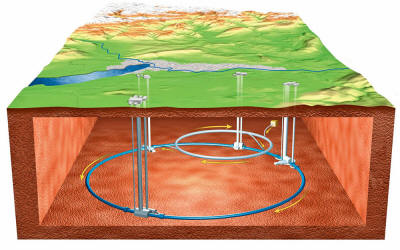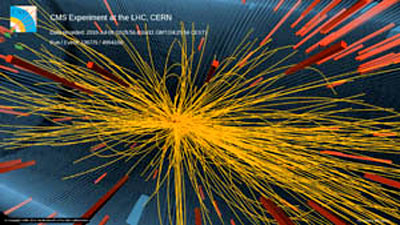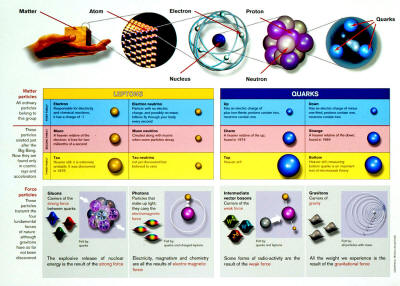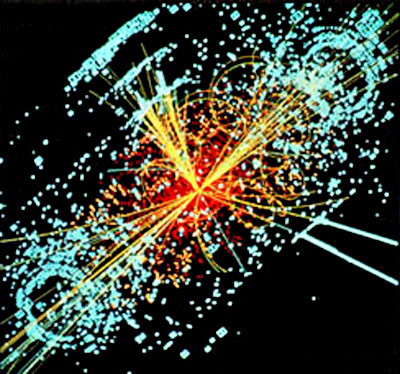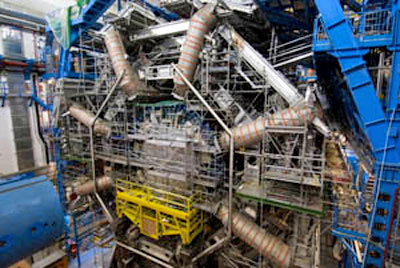|
Overall view of the LHC
(Image courtesy of
CERN.) On March 30, 2010, physicists at the Large Hadron Collider (LHC), near Geneva, Switzerland, coaxed two beams of protons - those tiny, positively-charged particles found in the nuclei of atoms - into slamming into each other.
Moving close to the speed of light, these protons hit head-on with a combined force of seven trillion electron volts of energy. To you and me, this much energy is like two swarms of kamikaze mosquitoes aiming for each other, but on the scale of subatomic particles it was a new record for high energy collisions.
It was also "a great day to be a
particle physicist," according to Rolf Heuer, Director
General of
CERN, the European particle physics laboratory that built
and runs the LHC. Physicists can't ask for more than new insights into these potent enigmas, can they? Yes, they can.
They can, they do, and they want the LHC to deliver.
When it's running at full capacity some time in 2013, the 17-mile (27 km) ring buried under the Swiss-French border will accelerate two beams of protons to 99% the speed of light before slamming them into each other with a total energy of 14 trillion electron volts.
A high energy proton
collision. producing more than 100 charged particles.
(Image of courtesy
CERN.) High energies are crucial because quantum mechanics, our theoretical model of the infinitesimal world, says almost all events are possible when dealing with fundamental particles, but some events are more probable than others.
The higher energies delivered by the LHC improve the chances that nice, big, never-before-seen particles will pop into existence from the energy left over from proton collisions. These new particles are what physicists want to see. Such particles are needed to fill out the mathematical description of all known particles - a list including electrons, quarks, and neutrinos - called the Standard Model.
The picture the Standard Model paints is highly precise as far as it goes, but some areas are incorrect, some incomplete, and a vital element just does not fit: gravity.
Theorists are hard at work proposing ways to smooth out the wrinkles, but without data, all patchwork is suspect.
Generally credited as one of the fathers
of string theory, Susskind recently emerged triumphant from
the
Black Hole War, an epic (among physicists) disagreement with
Stephen Hawking regarding whether quantum effects hold sway over
black holes. (They do.)
Diagram of the
Standard Model
(Image courtesy
of CERN.) The universe gives every indication of wanting to be a tidy place.
There are four forces, but three of them,
...have been
shown to be manifestations of the same force.
Dubbed the "God particle" by Leon Lederer, a Nobel Prize winner who was apparently a bit more media-savvy than your average physicist, the Higgs is the only particle of the Standard Model which has not been shown experimentally to exist.
CMS: Simulated Higgs to two jets and two electrons.
(Image courtesy
of CERN.) The Higgs boson "tells" other particles about the presence of the Higgs field, the real source of the mass.
Howard Haber, of the Santa Cruz Institute for Particle Physics (SCIPP) at the University of California, Santa Cruz and one of the authors of The Higgs Hunter's Guide, likens the effect of the Higgs field on a particle to that of a vat of molasses on a speeding bullet.
Analogies involving the bizarre world of subatomic particles rarely are.
Perhaps Lederer knew what he was doing when he gave the Higgs its divine moniker. Regardless, the importance of the particle to the Standard Model is not up for debate.
But the Standard Model displays only one
type of symmetry breaking. The big hope is that the LHC will show
the cracks in a type of symmetry not yet proven to exist:
super-symmetry, or
SUSY.
If SUSY exists, it must be broken
because each particle/sparticle pair should have the same mass. If
each known particle had an almost-twin with the same mass, those
twins would already be tucked into their enclosures at the particle
zoo of the Standard Model.
Kim Griest, an astrophysicist at the University of California, San Diego, puts it a little more strongly.
What makes SUSY so compelling?
Another reason, a little less dramatic but still of great importance to cosmologists and astrophysicists, was first proposed by by Joel Primack of SCIPP in 1983.
Primack suggested that the LSP, the lightest super-symmetric particle, could explain the 80% of matter in the universe that's hidden from our sight and only apparent through its gravitational effects on the stuff we can see. Apparently this dark matter, as it's called, cocoons our galaxy, and the galaxies next door in our Local Group, and all the galaxies in all the super-clusters around us.
If Primack is right, SUSY and dark matter are a two-for-one deal.
This possibility has cosmologists and astrophysicists waiting right alongside the particle physicists.
There are a lot of reasons to hope the
LHC uncovers super-symmetry.
Some have candidates for dark matter,
some do not. Some have extra dimensions, and some do not. Even the
Minimal Super-symmetric Standard Model (MSSM), the smallest
possible rewrite of the Standard Model to contain a viable version
of super-symmetry, adds about 120 new parameters, the values of
which can vary.
If SUSY exists but the LHC can't find it, Susskind says,
In other words, the answers to some questions might require "fine-tuning," a term even more distasteful to physicists than "God particle."
Fine-tuning the value of a cosmic parameter means admitting that our universe is the way it is "just because" instead of as a logical consequence of a deeper theory.
In other words,
According to both Dine and Tom Banks, another SCIPP physicist, what the LHC will really do is help cross possible SUSY models off the list.
Neither is willing to wager on what might remain.
But the LHC is a six-billion-dollar bet
that it is.
Inside the LHC
(Image courtesy
of CERN.) Physicists are going to have to wait a bit longer to see whether they will rake in the chips or leave the table with empty pockets.
The first order of business for the LHC is to spend 2010 and 2011 rediscovering all the known particles of the Standard Model. This will demonstrate not only that the machine is working, but that we're capable of correctly interpreting the tremendous amounts of data the LHC generates.
2012 will be spent on
upgrades. The LHC will start running at full capacity some time in
2013.
According to the presentation given by Ian Hinchcliffe, a member of the Theoretical Physics Group of the Lawrence Berkeley National Laboratory, the accelerator and - possibly even more important - the detectors are working well.
However, there is no plan to speed up the commissioning process. No one wants another day as bad as September 19, 2008.
Dine thinks the time waiting should be spent writing more papers with more testable predictions. Banks has another idea.
Would they bet on their own theories?
In true physicist fashion, they debate the most logical way to wager.
Letting It Ride
Everyone interviewed zeroed in on the main problem - no money to try
again.
The LHC is designed to address certain questions and the people working on those questions might be in trouble, she allows, but,
Banks is looking forward to the unexpected.
Susskind admits that there will be "tremendous disappointment" if the LHC does not deliver, but,
The end of physics will come with the end of questions, and the end of questions, Susskind believes, will only come with the end of people.
|

